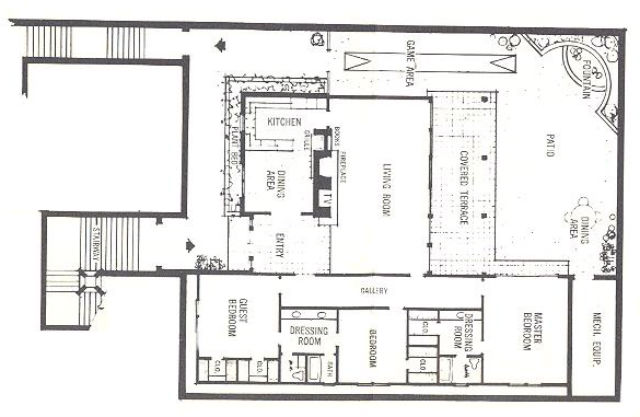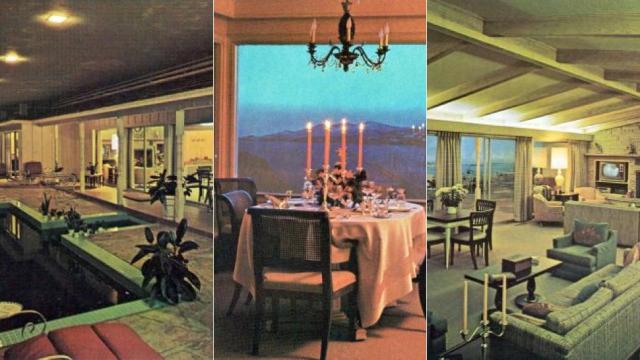You wouldn’t believe it just by looking at it, but this slice of 60s Americana is located three feet underneath a New York City park. Or, at least, it was back in 1964. Whether it’s still there remains a mystery — one almost as fascinating as the reason it was constructed in the first place.
The late 1950s and early 1960s marked the most dangerous days of the Cold War. Tensions with the Soviet Union had reached a boiling point, resulting in an uncomfortably close brush with full-scale nuclear annihilation during the Cuban Missile Crisis. This threat of radioactive extermination was enough to whip the American people into a full-blown security frenzy not seen again until the days following 9/11. This public hysteria served to boost interest in bunker homes , which had been marketed — largely unsuccessfully — to the American public for the a decade. Into this frenzy stepped Jay Swayze, a contractor from Plainview, Texas, with a vision to build not just underground homes, but entire communities, towns, and cities — a veritable utopia of mole men and women.
But before we delve into Swayze’s involvement with the NYC bunker in the spring of 1964, let’s first jump back a few years to Plainview in the late 1950s. The city of Plainview was soliciting contracts to construct small nuclear bomb shelters for its citizens in the event that Moscow completely lost its mind and decided to nix a tiny town at the base of the Texas panhandle. Swayze won that contract based on his functional — albeit bare-bones — 6 x 8 foot bunker capable of housing six adults for as long as it would take for the radiation to clear. More importantly, this victory spurred him to think that perhaps people could forgo building a separate shelter in case of nuclear winter and simply put their primary homes underground instead.
To prove that living underground was not only not creepy but could be downright cozy, Swayze dug out a 2,800 square foot hole in the ground of his Plainview property, filled it with a 10-room ranch-style mansion, and then moved himself, his wife, and two daughters into it.
Unfortunately, what he was selling, nobody else was buying. It turns out that convincing an American public in the grips of a Space Race, and inundated with romantic visions of living beyond the stars like Buck goddamn Rogers in the 24th century, that they wanted to instead live a yard under the Earth (it’s like you’re already halfway in your grave!) is a bit of a tough sell.
In fact, the only people that showed any interest in the labour intensive and expensive process were uber-wealthy fatalists like Avon Cosmetics founder Jerry Henderson, who bought two — one for his Boulder estate and another for his compound in Las Vegas . And good thing, too, because Henderson’s support would soon prove vital to Swayze’s business plans.
Taking the 1964-1965 World’s Fair by Storm

Image: AP Images
Between the cantankerous presidential campaign between Nixon and Humphreys, the fallout from the disastrous Chicago Democratic Convention, and the international firestorm that still raged around the Cuban Missile Crisis, there wasn’t a whole lot for the American people to rally behind — except for the World’s Fair, that is. Held on nearly a square mile of Queens parkland — Flushing Meadows, specifically — and filled with hundreds of exhibits from across the country and around the world, the 1964-1965 World’s Fair showed off the most exciting ideas and revolutionary products of the time.
But with industry heavyweights like GE creating enormous walk-through pavilions, touting life in the Space Age, the chances of a small-time Texas contractor getting a booth to show off his underground house were nearly non-existent. But a small-time Texas contractor that happened to know the head of the planet’s largest cosmetics manufacturer? That’s an entirely different matter.
Because of his connection, Swayze was able to not only score a prime presentation space between the Hall of Science and the Port Authority Heliport, but also enjoy a good deal of press interest in the run up to the fair. “Most of the architectural highlights of the World’s Fair spiral skyward,” the New York World-Telegram & Sun reported on November 18, 1963. “And then there’s the Underground World Home.”
The fact that the home required two months of digging and construction 15 feet beneath the Flushing Meadow marshland — all financed by Henderson — before much of the rest of the fair was even begun only helped to highlight Swayze’s project. Remember, for the visitors to the World’s Fair, it’s a fun day at an educational amusement park — but for the companies and countries presenting, this was a golden moneymaking opportunity: The chance to display their wares in front of millions of people with checkbooks. Even in the 1960s, getting this sort of audience reach was only achievable by major corporations and the international interest that it garnered was challenging, if not impossible, otherwise.
And while other exhibits like the 12-story tall stainless steel Unisphere and the 22o-foot tall observation decks at the New York State Pavilion trumpeted up towards the heavens, the exhibit at Block 50, Lot 5 featured only a small garden and water fountain. The real exhibit was underneath.
What 5,600 Square Feet of Subterranean Mansion Looks Like
Dubbed the Underground World Home, this model fallout bunker was based on Swayze’s own home design. Marked by a small display describing the construction techniques in addition to the garden and water works, visitors had to descend a short staircase to get down to the three-bedroom home itself.

Image: Souvenir Brochure
The entire structure — both the house and the “yard” — was surrounded by a concrete-steel shell 20 inches thick at the floor and between 10 and 13 inches thick at the walls and ceiling. This superstructure, along with the two million pounds of soil packed on top of it, was supported by an 18-inch steel girder frame and swaddled by a three-layer wrapping of water-tight Celotex panels. The shell was so strong that it could support an above ground garage or guest hose. All utilities — gas, water, electric, and ventilation — were all routed through a singe central point for easy access.
The shroud of millions of pounds of soil and rock not only served as sound and heat insulation for the underground home but also protected the house from natural disasters such as fire or tornadoes.
The home itself featured a slightly smaller floorplan than Swayze’s Texas version, but did incorporate an additional terrace area — complete with fake trees, grass, and shrubs — and fountain. It also featured upgraded pier and beam construction as well as wood floors.
According to a visitors booklet distributed at the Fair:
A few feet underground can give man “… an island unto himself;” a place where he controls his own world – a world of total ease and comfort, of security, safety and above all, privacy.
Climate Control: Create your own climate by “dialling” temperature and humidity settings. Pressurize the structure – much as a plane cabin is pressurised-and create any season of the year. Underground, one is free of the outside climate, and health no longer depends on it. Sufferers of chronic colds, asthma, sinus and allergies enjoy relief and the healthy man feels healthier.
The air in underground structures is drawn through a central point assuring absolute control of all climate factors: the breeze of a mountaintop, the exhilarating high-pressure feeling of a Spring day can be created at will.
Atmosphere Control: Live in air completely free of impurities and so clean that housekeeping is reduced to one light dusting a month. Passage of the air through fibre filters and electrostatic precipitators removes smog, smoke, automobile exhaust fumes and similar by-products of urban and suburban life. The constant, automatic flow of thousands of tons of fresh, filtered air ensures ideal ventilation without any danger of harmful cross-drafts.
Sound Control: Sound or silence is yours to choose underground. Thousands of tons of steel, concrete and earth prevent all sound from entering unless you invite it in. The clamor of traffic, jets, noisy neighbours – all are gone with a turn of a switch and you are free to rest in silence, or experience for the first time the full range of sensations that today’s sensitive stereo systems are able to produce.
Economy: Underground structures require practically no maintenance, depreciate little, and have a longevity literally longer-than-lifetime. Thus initial costs, which are slightly more than custom-designed surface construction, are quickly offset. Insurance below is a mere one-eighth of normal rates; the costs of utilities in a home surrounded by tons of natural insulation where temperatures vary only a few degrees throughout the year, are about one-third. Finally, underground construction allows double use of real estate; the overhead ground surface may be used for sunrooms, garages, or a playground with enough room left over for a garden or private park.
Security and Privacy: Life underground is free from natural hazards, even earthquakes. An underground structure cannot be destroyed by fire. Its location is less susceptible to theft and other criminal mayhem. Perhaps, most important, you have the comfort of being alone when you wish. Free from the involvement of neighbours, the danger of intruders, the home once again becomes “a man’s castle.”
If you put it that way, who wouldn’t want to live in an underground bunker?
Though estimates differ from what Swayze and the Fair organisers claimed at the close of the show, between 500,000 and a million people visited the Underground World Home in 1964 alone, with just under a million more arriving during 1965. But as with all World’s Fairs, at the close of the exhibit all but the most revolutionary exhibits are dismantled and disposed of. The Observation Towers from Flushing Meadows and the Palace of Fine Arts in San Francisco are two standout examples of spared structures, though the world’s first Ferris Wheel did not fare as well.
However, tearing a 5,600-square foot slab of 20-inch thick concrete out from under three feet of topsoil is an entirely different matter than knocking down some plywood fronts (and just slightly more expensive than putting the damn thing in there to begin with). Records on whether the home was actually dismantled are unclear, though some historians argue that the most cost effective move would have been to simply strip the exhibit down to its studs, seal the entrance, and leave the structure to wait for future archaeologists to rediscover in the far future.
Digging Up the Past for Science
The mystery surrounding the hidden home has grown into something of an urban legend in the 49 years since the Fair ended, and more than a few researchers have gone looking for the remnants of Swayze’s dream. Now, historian Lori Walters of the University of Central Florida has applied to the NYC Parks Department for permits to conduct a survey using ground-penetrating radar to locate the structure.
“Ground penetrating radar would be a non-invasive first step to determine what might remain of the underground structure,” she explained to Inhabitat. “Soil type may not permit us to conclusively determine the structure’s existence. The goal is not to uncover the Underground Home nor to provide full access to it. The greatest extent of exploration would be through an endoscopic camera and should that reveal an interior that is traversable”
Though his bunker business never took off the way he had hoped, Swayze did eventually write a book on the subject: Underground Gardens and Homes: The Best of Two Worlds, Above and Below. The rest of Swayze’s legacy remains buried somewhere in Flushing Meadows, just waiting to be rediscovered. [NYWF14 – Narratively – Popular Science]
